Guild systems in multiplayer fantasy adventure games enhance player engagement and foster collaboration. They promote community building and offer unique rewards while influencing game dynamics through competition. Challenges such as coordination difficulties and unequal participation can impact the experience. Innovative trends for 2025, including cross-platform integration and AI-driven matchmaking, aim to improve guild interactions and player satisfaction.
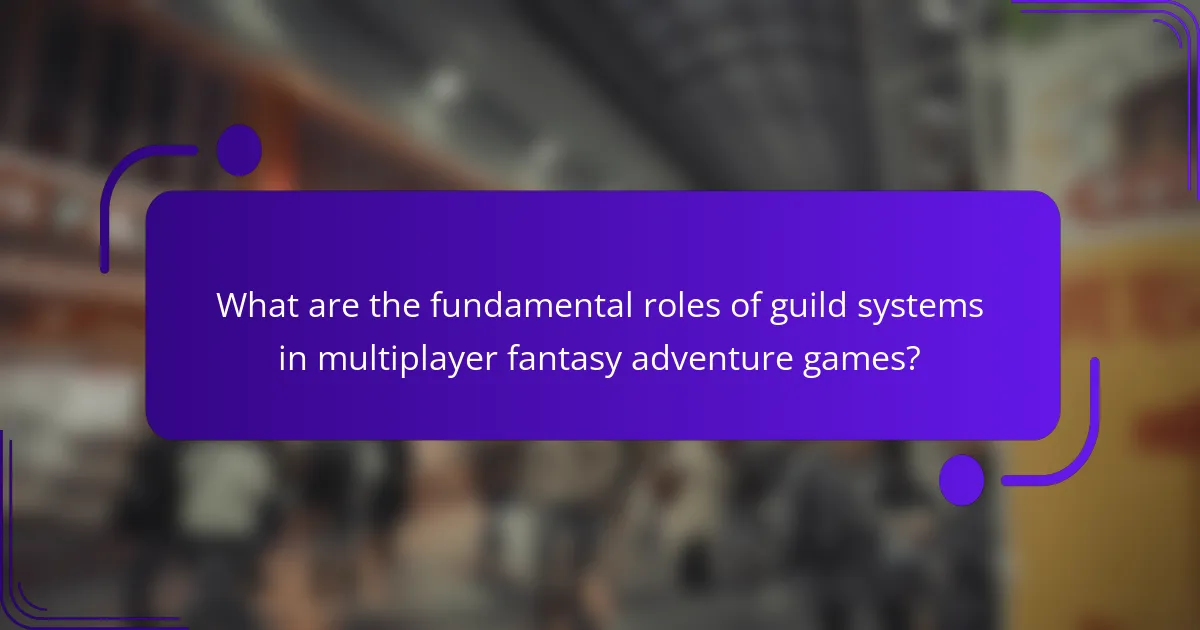
What are the fundamental roles of guild systems in multiplayer fantasy adventure games?
Guild systems in multiplayer fantasy adventure games serve essential roles in enhancing player engagement and collaboration. They facilitate social interaction, provide a structured environment for teamwork, and offer unique rewards that enhance gameplay.
Guilds promote community building by connecting players with shared interests. This fosters friendships and enhances cooperative gameplay experiences. They also create a sense of belonging, motivating players to invest time and effort.
Additionally, guild systems often include unique attributes such as exclusive quests and resources. These features incentivize players to participate actively, driving game progression and enhancing overall enjoyment.
Lastly, guilds can influence game dynamics through competition, enabling players to engage in events such as guild wars. This adds depth to gameplay and encourages strategic planning among members.
How do guild systems enhance player collaboration and social interaction?
Guild systems enhance player collaboration and social interaction by creating structured environments for teamwork. Players can join forces to achieve common goals, share resources, and strategize together. This fosters a sense of belonging and community.
Guilds often feature unique attributes, such as specialized roles or ranks, which enhance interaction. Players can communicate through in-game chat systems, facilitating real-time collaboration. Events organized by guilds further strengthen bonds among members, encouraging participation and teamwork.
As a result, players experience increased engagement and satisfaction, leading to long-term retention in the game. Collaborative challenges and rewards motivate players to work together, deepening their social connections.
What core features define successful guild systems?
Successful guild systems in multiplayer fantasy adventure games feature strong community engagement, clear leadership structures, diverse activities, and effective communication channels. These elements foster collaboration and enhance player experience.
Strong community engagement encourages members to participate actively and build relationships. Clear leadership structures provide direction and accountability, ensuring that guild objectives are met. Diverse activities, such as raids and social events, keep members motivated and invested. Effective communication channels facilitate information sharing and coordination, enhancing overall guild performance.
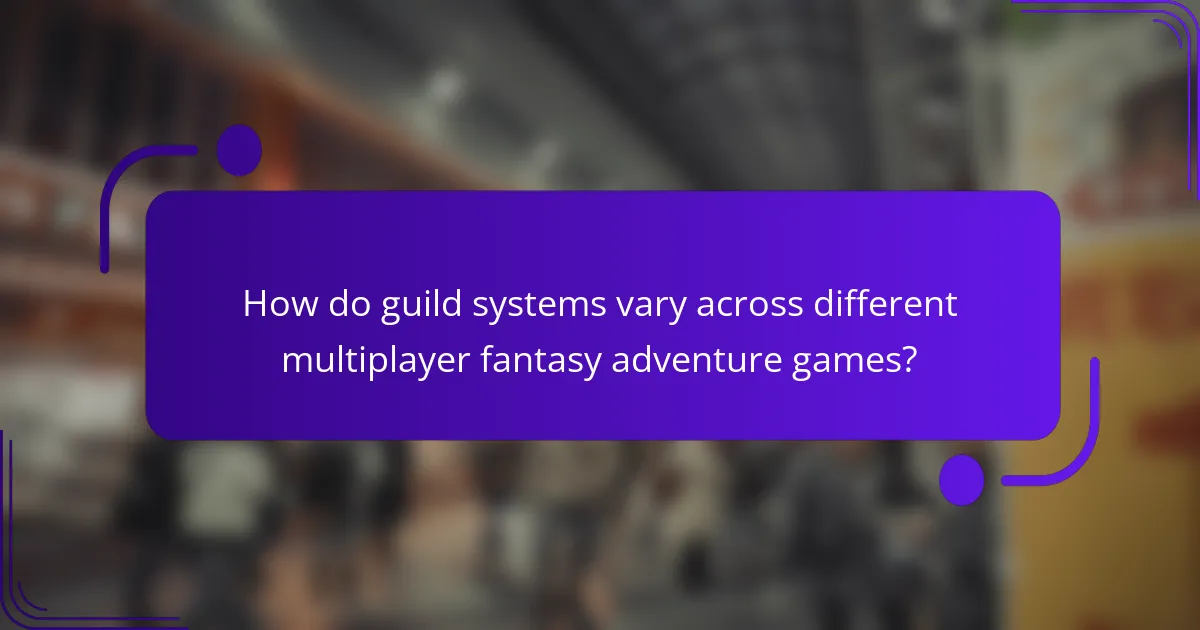
How do guild systems vary across different multiplayer fantasy adventure games?
Guild systems in multiplayer fantasy adventure games vary significantly in structure and function. Some games emphasize cooperative gameplay, while others focus on competition among guilds.
For example, in World of Warcraft, guilds offer structured hierarchies and benefits like shared resources and raid participation. In contrast, games like Final Fantasy XIV present a more casual approach, allowing players to join multiple guilds and engage in diverse activities.
Additionally, unique attributes such as guild housing in games like Elder Scrolls Online provide social spaces for members. Rare attributes may include cross-game guild systems, enabling players to maintain their guild identity across different titles.
These variations enhance player engagement and community building, reflecting the diverse design philosophies of each game.
Which popular games exemplify unique guild structures?
Games like “World of Warcraft,” “Final Fantasy XIV,” and “Guild Wars 2” exemplify unique guild structures. “World of Warcraft” features a hierarchical system with raid teams and guild ranks. “Final Fantasy XIV” offers free company systems that allow for player-created communities with unique benefits. “Guild Wars 2” emphasizes guild halls and customizable features, enhancing social interaction. These games showcase diverse approaches to guild dynamics, fostering community and collaboration.
How do regional differences influence guild system designs?
Regional differences significantly impact guild system designs in multiplayer fantasy adventure games. These variations shape player interactions, governance structures, and cultural themes within guilds.
Cultural influences dictate the values and norms that guilds embody. For instance, guilds in Asian regions may emphasize collectivism, fostering cooperative gameplay and shared resources. Conversely, Western guilds often promote individual achievement and competitive dynamics.
Geographical factors also affect resource availability and gameplay strategies. In regions with harsh environments, guilds might prioritize survival tactics and resource management. In contrast, areas with abundant resources may encourage exploration and adventure-focused guild activities.
Lastly, technological accessibility varies by region, influencing guild communication and organization. Regions with advanced technology can support more complex guild structures and real-time interactions, enhancing player engagement and collaboration.
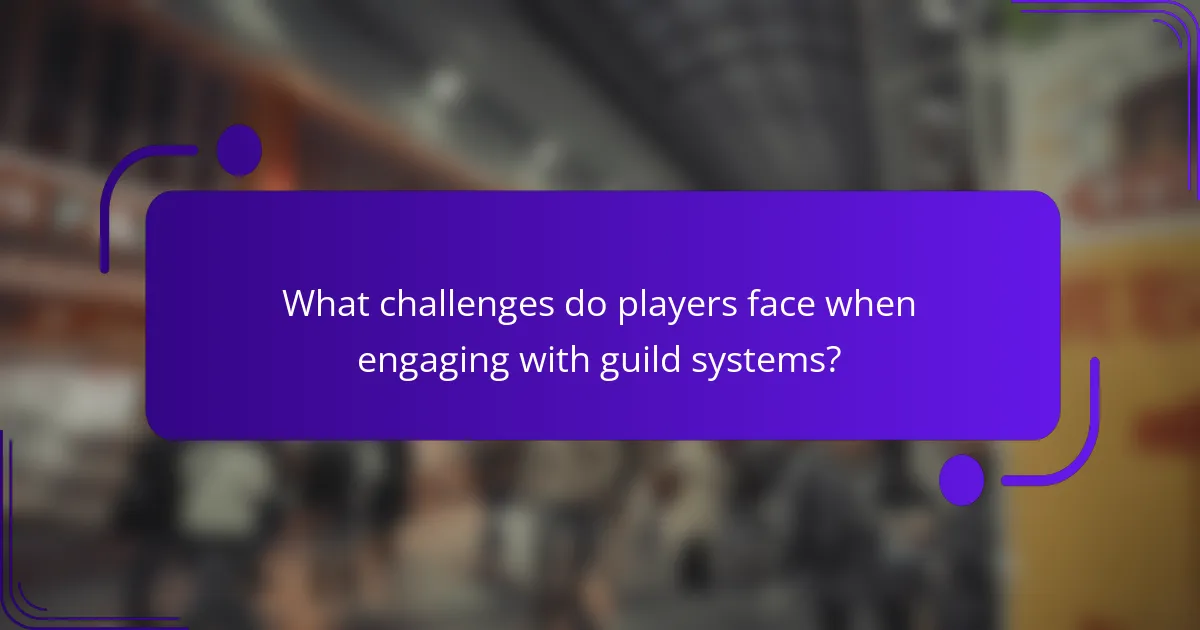
What challenges do players face when engaging with guild systems?
Players face several challenges when engaging with guild systems in multiplayer fantasy adventure games. Key issues include coordination difficulties, unequal participation, and conflicting goals among members.
Guilds often struggle with effective communication, leading to misunderstandings and inefficient teamwork. Participation can vary widely, with some players contributing significantly while others remain inactive, creating frustration. Additionally, differing objectives can cause internal conflicts, making it challenging to achieve collective goals.
These challenges can hinder the overall experience, impacting player satisfaction and retention in the game.
How can guild leaders effectively manage member dynamics?
Guild leaders can effectively manage member dynamics by fostering communication, establishing clear roles, and promoting inclusivity. Open dialogue encourages members to share concerns and ideas, enhancing group cohesion. Defining roles helps streamline responsibilities, reducing conflicts and confusion. Inclusivity ensures all members feel valued, which strengthens commitment and participation. By implementing regular feedback sessions, leaders can adapt strategies to evolving group needs, maintaining a positive environment.
What are common pitfalls in guild recruitment and retention?
Common pitfalls in guild recruitment and retention include lack of clear goals, poor communication, and inadequate onboarding. Many guilds fail to define their purpose, leading to mismatched expectations. Ineffective communication can create misunderstandings among members, reducing engagement. Additionally, insufficient onboarding processes may leave new recruits feeling lost and disconnected, resulting in higher turnover rates. Addressing these issues can enhance member satisfaction and loyalty.
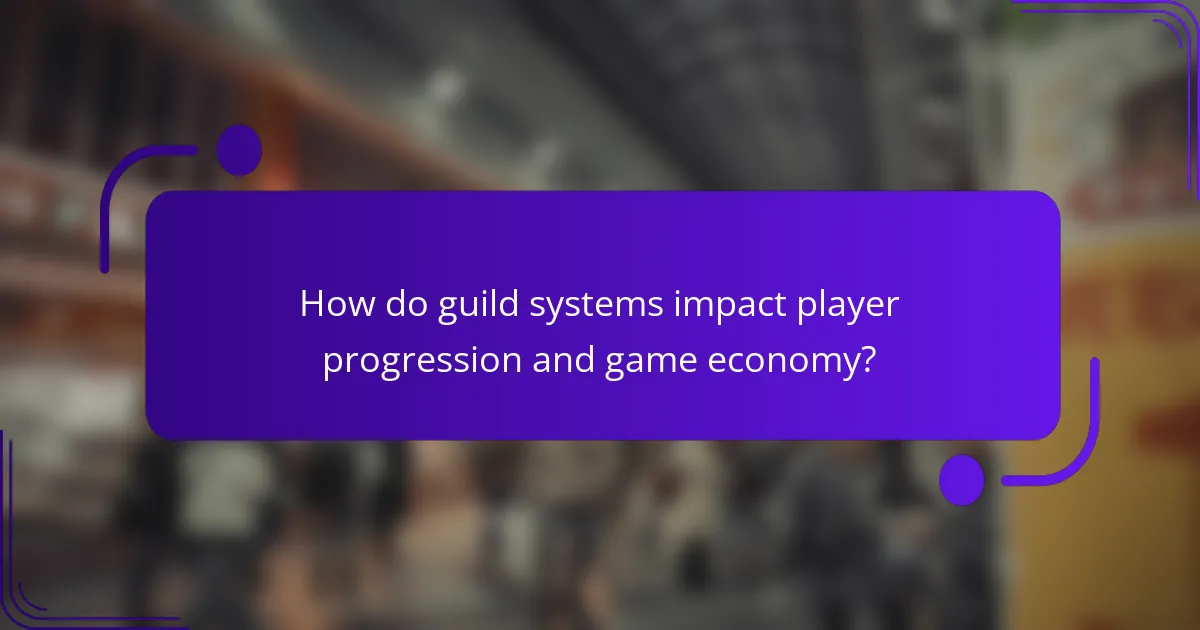
How do guild systems impact player progression and game economy?
Guild systems significantly enhance player progression and influence game economy by fostering collaboration and resource sharing. Players in guilds can access exclusive quests, items, and experience boosts, accelerating their advancement. This cooperative dynamic creates a vibrant in-game economy where guilds trade resources, impacting supply and demand. The unique attribute of guild leadership roles often allows for strategic planning, leading to optimized resource allocation. As a result, guild systems not only enhance individual player experiences but also shape the overall economic landscape of the game.
What benefits do guilds provide in terms of resource sharing?
Guilds in multiplayer fantasy adventure games enhance resource sharing by fostering collaboration among players. They allow members to pool resources, share items, and exchange knowledge, leading to improved gameplay experiences.
Guilds often provide a structured environment for resource management, which can include crafting materials, consumables, and rare items. This collective approach reduces individual effort and increases efficiency in acquiring necessary resources.
Additionally, guild systems may include unique attributes such as exclusive access to guild-specific quests or events that yield valuable rewards. These features encourage active participation and strengthen community bonds among players.
As a result, guilds serve as vital networks for resource sharing, ultimately enhancing the overall success and enjoyment of members in the game.
How do guild achievements affect individual player status?
Guild achievements significantly enhance individual player status by showcasing contributions and skills. Players gain recognition through achievement points, which often correlate with their rank within the guild. This status can unlock exclusive rewards and privileges, fostering competition and collaboration among members. Furthermore, high achievement levels can attract new players, enhancing the guild’s overall reputation. Players with notable achievements may also receive special titles, enhancing their visibility in the game’s community.
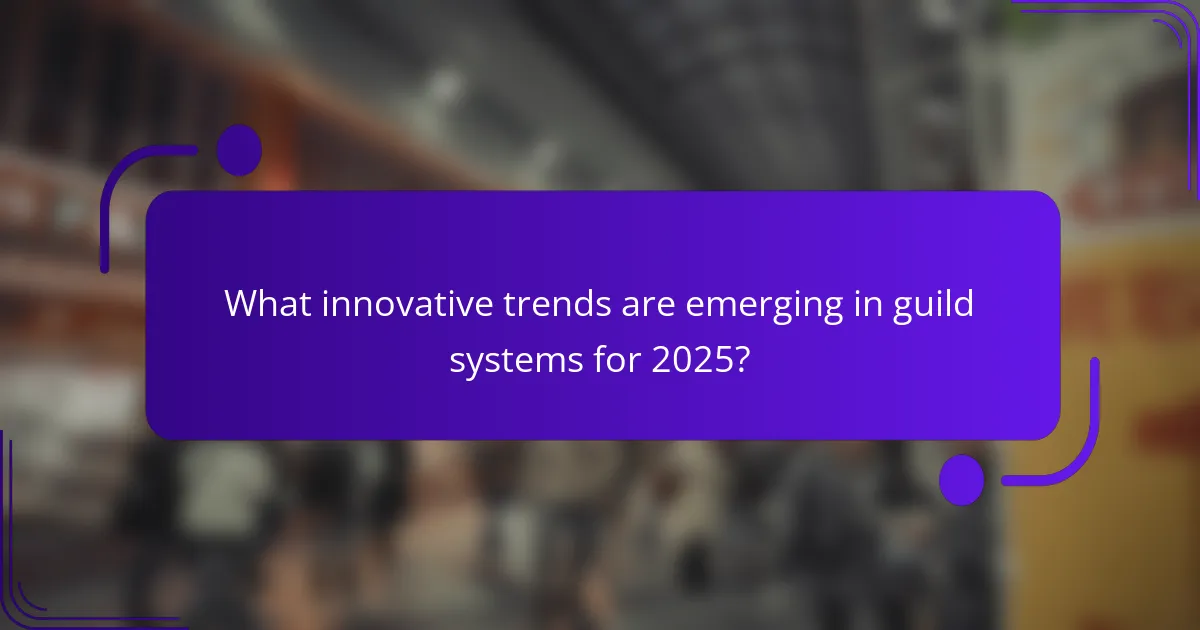
What innovative trends are emerging in guild systems for 2025?
Innovative trends in guild systems for 2025 include enhanced cross-platform integration, AI-driven member matchmaking, and dynamic quest systems. These developments aim to foster stronger community engagement and personalized experiences. Cross-platform integration allows players from different devices to collaborate seamlessly. AI-driven matchmaking optimizes team compositions based on individual player strengths and preferences. Dynamic quest systems adapt in real-time to member actions, creating a more immersive gameplay experience. These trends reflect a shift towards more interactive and player-focused guild dynamics.
How are technology and tools shaping the future of guild management?
Technology and tools are revolutionizing guild management by enhancing communication, organization, and gameplay coordination. Advanced platforms streamline member recruitment, event scheduling, and resource sharing, improving overall efficiency.
Innovative tools, such as voice chat and collaborative software, foster real-time interaction, allowing guilds to strategize effectively during gameplay. Gamification features in these tools engage members, promoting participation and loyalty.
Data analytics provide insights into member performance and activity trends, enabling guild leaders to make informed decisions. Automation of routine tasks frees up time for leaders to focus on community building and game strategy.
Overall, technology and tools are transforming guild management into a more dynamic and engaging experience for players.
What role do cross-platform capabilities play in guild systems?
Cross-platform capabilities enhance guild systems by allowing players from different devices to interact seamlessly. This integration fosters a larger community and encourages collaboration among players. It also improves player engagement through consistent experiences across platforms. Moreover, cross-platform features can lead to increased guild activity and recruitment, as players can join without device restrictions. Ultimately, this capability strengthens the social dynamics within guild systems, making them more vibrant and inclusive.
What are the best practices for optimizing guild engagement and activity?
To optimize guild engagement and activity, focus on fostering community interaction, providing meaningful rewards, and facilitating communication. Encourage regular events and challenges to maintain member interest.
1. Create engaging events that require teamwork.
2. Offer rewards that enhance gameplay and acknowledge contributions.
3. Use communication tools to keep members informed and connected.
4. Encourage feedback to improve the guild experience.